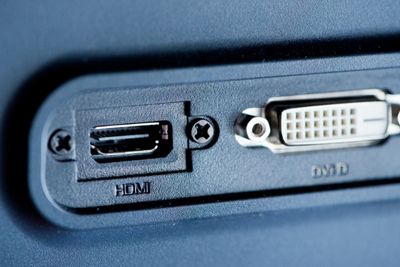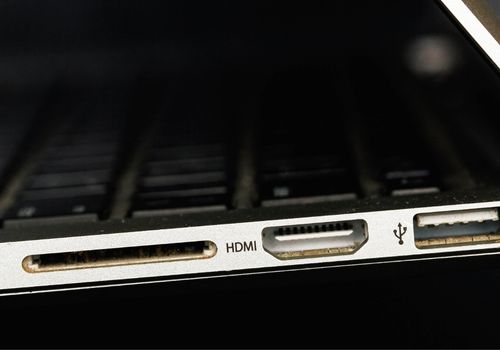
HDMI Output ports are the ports you plug HDMI cables into to transfer data from your device, like in gaming consoles. Input ports are used to bring in audio and video signals from other digital devices, such as in TVs.
I have a few consoles at home, so I had to figure out the right cables to use to play them on my TV screen.
This may be something you want to do, so I decided to show you the differences between the two input and output ports.
Contents
I've discussed both HDMI ports individually, then compared them side-by-side. Let's get to it.

HDMI inputs are found on TVs and home theater receivers. These are special ports that are designed to accept the end of an HDMI cable, which will then let audio and video signals be transferred in.
HDMI outputs feed the audio and video signals into the HDMI inputs of other devices. So devices like Blu ray players, game console, and most laptops come with them.
To summarize, input ports are the entries that you plug HDMI cables in to play audio and video. The other end of the cable is plugged into the HDMI output, which will be transferring the audio and video you want to be played.
You might be wondering how you can tell the difference between the two. Well, they are usually marked.
If not, you can figure out which type of port you have through the product manual.
There are a couple of different HDMI port versions out there. The version you have will depend on the manufacture date of the device.
You can find out what version you have by looking at the number on it.
Here’s a breakdown of the key specs of HDMI versions:
The number next to the port is the highest video resolution it can handle (or its refresh rate). So the higher the number, the better the frame rate and resolution that you will get.
Most devices on the market right now come with at least HDMI 1.4. It supports high definition video, so you can play 4K video without an issue.
Let's take a look at the HDMI ports on different devices, and whether they can send or receive audio and video.
Laptops have output ports. You'll be able to transfer analog video signals from them to other digital devices. Up to now, there are no laptops with HDMI input ports on the market.
If your PC's HDMI port is on a video capture card, it has an input port. However, if the port is on its motherboard or graphic card, it uses output.
Most digital TVs have at least 3 different HDMI ports. At least 2 of them are for multi-use.
You can use both video input and output on your TV with just one cable, no matter the model or type.
Lastly, let's talk about monitors. Monitors are input devices - they accept both audio and video signals.

The most important points to keep in mind when buying HDMI cables are resolution, HZ speed, and connector type.
For instance, if you're planning on playing video at 4K in 120 HZ, you will need a cable that can handle these specifications.
You'll also need at least 10.2 GBs of speed if you are playing 4K video.
Here is a more detailed overview of the bandwidth that you need:
My laptop's output port stopped working once, and it was difficult to figure out what was causing the problem.
So to save you the trouble, I decided to run through all the fixes that worked.
Let's get to it.
You might not be dealing with a software or hardware problem. Most likely, you haven't plugged in the HDMI cable to your computer properly.
Unplug it, and try again. You should be able to transmit high resolution audio and analog video signals to an external source now.
You could be dealing with a minor glitch. You should be able to clear it by restarting your computer.
All you need to do is press the Windows logo, click on the Power off button and then tap Restart.
Once your device reboots, try plugging the other device in.
At the same time, the device that you're trying to plug in might be glitching. Just restart it and plug it back in again.
It's possible that you have an outdated graphics card that is bugging out.
Download the latest software version so that it can transfer audio and video signal again.
Here's how:
If you're still having no luck, it might be time to update your computer's OS. It might have been a while since you updated it, so it could be bugging out and preventing your HDMI adapter from working.
Here's how:

HDMI stands for High Definition Multimedia Interface. Essentially, it is an HD signal used to transmit high resolution audio and video from one external device to another via a single cable in one direction.
HDMI ports come in different versions, types, and sizes. Most of them are medium-sized, but there are also mini and micro HDMI.
As mentioned, the ports can either be for input or output. The port you have will affect whether you can transmit audio and video signals, or only receive them.
An HDMI input port will be in a device like a TV, and an output port will be in a device like a Blu Ray player.
HDMI input is where you feed HDMI cables in, and transfer high-resolution audio and video to your device from another one; for example, from home theater receivers or DVD players to your television.
HDMI output is the port that lets you plug in a HDMI cable to send data to another device's input port.
Getting a good HDMI connection is not as easy as you think. To get the most out of your digital processors, you will need the proper HDMI cable. For the best HDMI connection, make sure that your cable can handle the specs of what you will be playing, and is fast enough for the source device.
I also discussed some additional information, like what you should do if your HDMI input is not working on your computer. There are some easy fixes like restarting your device, and updating your graphics driver.
